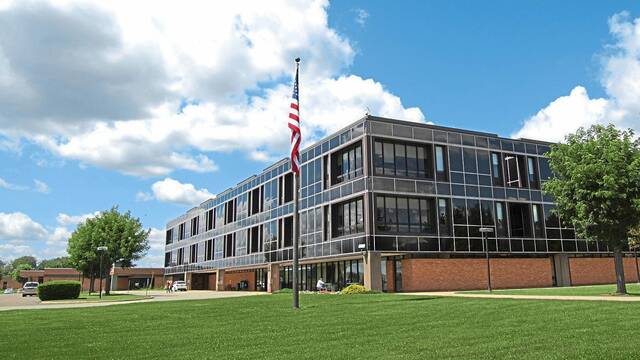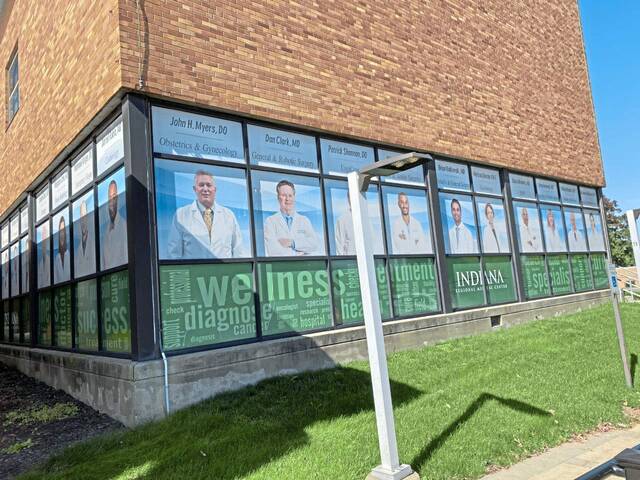Why some Western Pa. hospitals choose to remain independent
Editor’s note: This is the final part of a three-day series examining the rapidly changing health care landscape in Western Pennsylvania.
Lynn Botelho has lived her life traveling the globe, navigating some of the world’s most time-honored academic institutions.
But when she was handed a cancer diagnosis, she looked no farther than 10 minutes from her home at one of the few remaining independent community hospitals in Pennsylvania.
“I fence in Pittsburgh with the Pittsburgh Fencing Club, so I know half of the people on the UPMC staff, and they said, ‘You’re coming here.’ But our little hospital (the former Indiana Regional Medical Center) has a nationally recognized breast center with Hillman (Pittsburgh’s UPMC Hillman Cancer Center),” said Botelho, 59, an Indiana University of Pennsylvania history professor and former Fulbright Scholar. She was diagnosed with BRCA-2 type breast cancer in 2020.
“It is phenomenal,” she said of the facility about 60 miles from Pittsburgh that was recently rebranded as IRMC. “Why go to Pittsburgh when I can get that kind of care? These people saved my life. I put my life in their hands.”
Though Botelho likes the idea of community-based medicine from an independent hospital run by people who live in that community, it’s a concept that is quickly fading as more health care systems merge in order to survive.
While a handful of facilities in Western Pennsylvania, including ACMH Hospital (previously known as Armstrong County Memorial Hospital) in East Franklin and St. Clair Hospital in Mt. Lebanon, have maintained their independence, many have joined systems such as UPMC, AHN, Penn Highlands and WVU Medicine.
Officials from ACMH Hospital and St. Clair Hospital declined requests for interviews.
The numbers
In 2010, 50% of the state’s hospitals were independent, whereas today only 15% boast that status, according to the Pennsylvania Hospital and Healthcare Association. Of those 20 remaining independent hospitals, fewer than 10 have more than 100 beds, according to the association.
Glen Melnick, professor of public policy at the University of Southern California, said those figures square with national trends.
He suspects they will be accelerated by recent challenges and predicts independent hospitals without big endowments or hefty cash reserves will become prime targets for takeovers.
Stephen Foreman, a health care economist at Robert Morris University, said several factors have helped the three local independent hospitals.
Location undoubtedly weighs in their favor.
St. Clair is located in the midst of an affluent community. Armstrong and Indiana both are an hour away from Pittsburgh, factors bolstering strong community loyalty, Foreman said.
“I suspect that St. Clair Health has the capacity to engage in the needs of the community much more dynamically than a large system would,” said Andrew Flynn, a Mt. Lebanon commissioner. “While I have no doubt the large systems are actively engaged within their communities, the opportunity to identify, engage and solve problems and bring solutions and resources quickly to the table is likely far more robust when your partners are locally based.”
Related:
• As Western Pa. hospitals expand, fears grow over higher health care costs
• Hospitals embrace mergers as path to survival
Like Botelho, Deborah Blystone of South Bend, Armstrong County, is grateful that quality specialty care was available to her at nearby ACMH, making it unnecessary for her to travel to Pittsburgh.
Blystone, 72, a retired tire store manager, recently was at the hospital every day for six weeks of radiation treatments. Her physician referred her to the hospital’s cancer center — a joint venture between Armstrong and Allegheny Health Network — after he discovered a lesion on her vocal cord that turned out to be Stage 1 cancer.
“It’s very convenient for us,” Blystone said. “I had my gallbladder out there, too. A lot of people here wouldn’t choose to go to Pittsburgh. We’re not used to that kind of traffic.”
Recently, when her husband collapsed at a party, she turned to the emergency room at the hospital to get him checked out.
“I don’t know what we would do if they weren’t there. Can you imagine getting into an ambulance and traveling to Pittsburgh? It’s an hour and a half on the parkway,” she said.
Financial reports indicate Armstrong, with 160 beds; Indiana, with 166 beds; and St. Clair, with 329 beds are in relatively good financial condition.
St. Clair’s total operating margin of 22.7% for 2021 (its revenue from operations and investments, after expenses) was nearly double the state average of 11.77%. Armstrong’s at 10.36% and Indiana’s at 9.36% also were solid, Foreman said.
Challenges for IRMC
This year, IRMC’s biggest challenge in serving the Indiana County market came when the IRS pulled its tax-exempt, nonprofit status for failing to file the required 990 forms for three consecutive years, CEO Stephen Wolfe said.
The forms, required of all nonprofits, detail the hospital’s finances, governance and activities to ensure its compliance with federal regulations.
The exemption allows hospitals to avoid taxes, borrow large sums through tax-exempt bonds and solicit tax-deductible donations from foundations and wealthy donors. Losing the status could be crippling.
Wolfe said officials didn’t learn about the revocation until July 25, eight months after it took effect in November 2021.
The Trib confirmed through an IRS letter to the hospital dated Nov. 1, 2022, that the tax-exempt status had been restored.
Wolfe dismissed it all as a “technical issue” dating to the onset of the covid-19 pandemic. He said IRMC was in the midst of an 18-month-long computer conversion when the pandemic struck in March 2020.
He attributed the “oversight” to the chaos of the pandemic as the hospital was thrown into crisis mode, halting elective surgeries, protecting the welfare of patients and staff, and scrambling for relief money to offset $5 million a month in losses.
“I don’t mean to downplay the importance of the exempt status,” said Indiana businessman Nathan Kovalchick, vice chair of IRMC’s board. “Unfortunately, anyone who deals with the IRS learns it is a one-way street. If you’re a citizen who is doing anything wrong, the IRS bends over backwards. But if you’re a business, it’s not like the IRS sends you a letter saying you missed a report. All of a sudden, you get a letter, and it’s like an iron fist coming down on you.”
He said smaller, independent hospitals such as IRMC are at a disadvantage in relation to larger health systems when it comes to handling this type of paperwork, particularly in times of crisis.
Peggy Outon, director of Robert Morris University’s Bayer Center for Nonprofit Management, called the lapse “mind boggling,” adding it was “far from a trivial oversight” for an institution as large as IRMC.
“If this was an oversight, the incompetence of overlooking something like that is incredible,” she added.
Community support
Despite such struggles, IRMC — Indiana County’s largest private employer — is respected in many corners of the community.
“It’s a big source of pride for us to remain independent, and it’s a big source of pride for (the) community,” Indiana County Commissioner Sherene Hess said.
She hopes all of that remains unchanged despite indications that bigger health systems are interested in the hospital.
Wolfe said UPMC, Allegheny Health Network and Conemaugh Health System are among those that have expressed an interest in acquiring IRMC.
“We chose to go an independent path,” Wolfe said. “We believe when you have local control and a volunteer board and management that is sleeping in the community, there is a difference in having as many services locally that you can provide in a high-quality manner as opposed to closing things down and centralizing them in a health system.”
He said joining another system could mean as many as 100 to 200 jobs outsourced from a community that already has suffered job losses from declining enrollment at its local university, fluctuations in the energy industry and a drop in population of more than 330,000 since 1980.
Wolfe added that some IRMC patients don’t have the luxury of going elsewhere.
“There is no question they’d rather forgo treatment than go into Pittsburgh,” he said.
Wolfe and IRMC are forging ahead with plans to break ground on a $13.8 million, 42-bed adult and pediatric neuropsychiatric institute in January. Given the shortage of psychiatric beds in Western Pennsylvania, he said it likely will draw patients from throughout the region.
In addition to its affiliation with UPMC through the Hillman Cancer Center at IRMC, the hospital has begun other partnerships outside Indiana County.
Two years ago, IRMC acquired the 39-bed Punxsutawney Area Hospital in a merger that Wolfe said was designed to help the smaller Jefferson County institution access services not available there. In August, it opened a joint venture with the 54-bed Chan Soon-Shiong Medical Center at Windber.
Recently, IRMC gained a stake in Westmoreland County with the opening of a physician practice on Frye Farm Road in Unity and the purchase of a 20% interest in Aestique, an independent ambulatory surgery center in the township.
Wolfe said projects such as IRMC’s Human Motion Institute, which has been able to capitalize on the growing demand for joint replacements, have been a big draw.
“Over 50% of our joint replacements are coming from outside of the county,” he said.
Even so, keeping costs in line is difficult at a facility that serves one of the country’s largest Medicare populations and lacks the clout of a big system when negotiating with private insurers for reimbursement.
Cost-cutting moves
The Pennsylvania Mountains Healthcare Alliance, a 14-member network of independent hospitals — including Armstrong and Indiana — that formed 25 years ago, has allowed members to cut costs by joining forces on issues such as purchasing and health insurance.
“We’re looking for size and scale when we can do something as a group while still remaining independent,” Wolfe said.
Joe Gribik, president and CEO of the alliance, said he knows the importance of independent community hospitals and the need for local control.
“I still think care needs to be driven locally and boards need to have input,” he said. “It’s been sad to watch some of the hospitals that have been acquired. … (They’re) just a shell of what they’ve been before.
“If you want care to be delivered in a local setting, independent is definitely the best way to achieve that goal. … The balance is, do you have the size and skill to pull that off?”
The alliance has not not been able to address one of the biggest issues facing health systems everywhere: a shortage of workers.
Wolfe said his hospital is turning to staffing agencies to fill nursing shortages at a cost of as much as $100 an hour per nurse.
“On these thin margins, you’re trying to thread a needle between recruiting and retaining and still trying to keep the hospital at break-even or better,” Wolfe said.
The hospital also just launched a nurse residency program to allow 20 new nurses a year get an opportunity to advance their educations and is working to recruit students from Indiana University of Pennsylvania and Westmoreland County Community College, which both send their students to IRMC for clinical rotations.
Some hospitals, like St. Clair, also have formed partnerships with national health care entities.
Its partnership with the Mayo Clinic allows St. Clair doctors to tap into specialties and subspecialties not offered at the local level.
“I think it is really a novel application to sharing resources without St. Clair having to make a huge investment in hiring multiple individuals,” said Dr. Mark Larson with the Mayo Clinic.
Similarly, Armstrong is part of the federal 340B Prescription Drug Program, which requires pharmaceutical manufacturers participating in Medicaid to sell outpatient drugs at discounted prices to health care organizations that are for many uninsured and low-income patients, according to the American Hospital Association.
Sixty percent of patients at the Armstrong hospital are on Medicaid or Medicare or are uninsured, according to federal records.
Constant innovation is key in the day-to-day life of an independent hospital, Wolfe said.
“I think we have been aggressively trying to grow,” he said, admitting, “trying to remain financially viable in Western Pennsylvania is challenging.”
Deb Erdley is a Tribune-Review staff writer. You can contact Deb at derdley@triblive.com or via Twitter @deberdley_trib.
Remove the ads from your TribLIVE reading experience but still support the journalists who create the content with TribLIVE Ad-Free.





